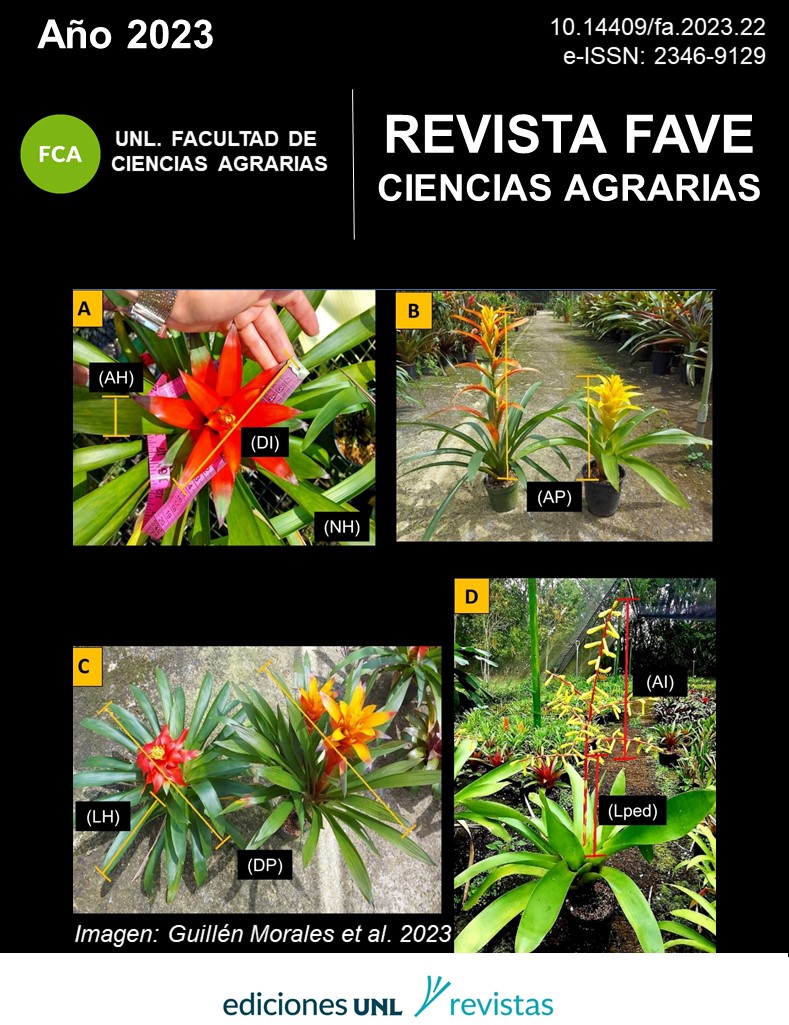Botanical extracts as a technological artifact for agroecological transitions: tests experiences in Cordoba, Argentina
DOI:
https://doi.org/10.14409/fa.2023.22.e0008Keywords:
agroecology, pest insect management, horticulture, interdiscipline, socio technical analysisAbstract
This article analyzes two technological frameworks in dispute in the Agrifood Region of Central Cordoba: the conventional (CTF), with a dominant presence in the agricultural sector, and the agroecological (AETF), with a recent trajectory but with an expansive tendency. This work proposes to deal particularly with one of the technological artifacts proposed in the TAETF that can be constituted as an alternative productive practice to the conventional one regarding pest insects management. The methodology is framed within the qualitative paradigm, relevant social groups were selected in relation to pest insects management and control without chemical synthesis inputs and then, within these groups, key informants were identified.
A first distinction was made between producers (conventional and agroecological) and professionals (extensionists and researchers). Conclusions on the performance of aphids control with a garlic-based botanical extract depends on the relevant social group. On one hand, there were valuable lessons learned by researchers, even though the results showed only positive trends: i) botanical extracts should not be thought of as direct substitutes for chemical synthetic inputs, ii) BE serve as an artifact that favors the transition on ways of thinking. On the other hand, for AE producers, the artifact works and allows them to confirm their trajectory and continuous accompaniment of other agroecological practices proposed by the AETF. While for conventional producers, it also works, but demands more labor, so its use is justified only in specific forms and at specific times.
References
Argüello Caro, E.B. (2020a, 15 de Octubre). Transición agroecológica en sistemas hortícolas del cinturón verde de Córdoba: aprendizajes y desafíos en los procesos de IAP en el uso de bioinsumos. [Webinar]. IV Jornada Agricultura Urbana y Periurbana, I Jornada Interprovincial Urbana y Periurbana, Córdoba y Santa Fé. https://youtu.be/vwn8K6NK2Z8
Argüello Caro, E.B. (2020b, 14 de Diciembre). Hablemos de bioinsumos - Jornada para productores. [Webinar]. INTA, Marcos Juarez. https://www.youtube.com/watch?v=Che9zQkl2Xs&t=1122s
Bijker, W. (1995). Of Bicycles, Bakelites, and Bulbs: Toward a Theory of Sociotechnical Change. MIT Presss.
Cáceres, D., Silvetti, F., Soto, G. & Ferrer, G. (1999). Las Representaciones Tecnológicas de Pequeños Productores Agropecuarios de Argentina Central. Desarrollo Rural y Cooperativismo Agrario, 3, 57-80.
Caron, P., Biénabe, E., Hainzelin, E. (2014). Making transition towards ecological intensification of agriculture a reality: the gaps in and the role of scientific knowledge. Curr. Opin. Environ. Sustain., 8, 44-52. https://doi.org/10.1016/j.cosust.2014.08.004
Catullo J. C., Argüello Caro, E., Narmona, L., Muñoz, N., Silbert, V., Yosviak, M., Scifo, A., Prado, A., Pietrarelli, L., Videla, M., Serra, G., Gaona Flores, M.A. & Viale, V. (2020). Construcción de conocimiento en redes de innovación para el uso de bioinsumos en sistemas hortícolas periurbanos. Agrociencia Uruguay, 24(NE 1), 342-359. https://doi.org/10.31285/AGRO.24.342
Censo Nacional Agropecuario (2018). Consultado el 13 de abril de 2022. https://cna2018.indec.gob.ar/
Duru, M., Therond, O. & Fares, M. (2015). Designing agroecological transitions; A review. Agron. Sustain, Dev., 35, 1237-1257.
Ferrer, G., Silvetti, F., Barrientos, M., Saal, G. & Francavilla, G. (2022). Análisis del marco tecnológico agroecológico de la región agroalimentaria de Córdoba. Revista Facultad de Agronomía de La Plata, Vol 121, Nro 1.
Giarraca, N. & Bidaseca, K. (2004). Ensamblando las voces: los actores en el texto sociológico. En Kornblit, A. L. (Coord.), Metodologías cualitativas en ciencias sociales. Modelos y procedimientos de análisis (1ra. ed., pp: 35 - 46). Editorial Biblos.
Giobellina, B. (2018). La alimentación de las ciudades Transformaciones territoriales y cambio climático en el Cinturón Verde de Córdoba. Ediciones INTA. https://inta.gob.ar/documentos/la-alimentacion-de-las-ciudades
Gliessman, S. R. (1998). Agroecology: Ecological processes in sustainable agriculture. CRC Press.
Gliessman, S., Rosado-May, F., Guadarrama-Zugasti, C., Jedlicka, J., Cohn, A., Méndez, V., Cohen, R., Trujillo, L., Bacon, C., & Jaffe, R. (2007). Agroecología: promoviendo una transición hacia la sostenibilidad. Ecosistemas, 16(1),13-23. https://www.revistaecosistemas.net/index.php/ecosistemas/article/view/134
Guzmán Casado, G.I. & Mielgo, A. (2007). La investigación participativa en agroecología: una herramienta para el desarrollo sustentable. Ecosistemas, 16 (1), 24-36.
Isman, M.B. (2017). Moving botanical insecticides from the laboratory to the farm. Industrial Crops & Products, 110, 10-14. http://dx.doi.org/10.1016/j.indcrop.2017.07.012
Kremen, C. & Miles, A. (2012). Ecosystem services in biologically diversified versus conventional farming systems: benefits, externalities, and trade-offs. Ecology and Society, 17(4), 40. http://dx.doi.org/10.5751/ES-05035-170440
Méndez, V.E., Bacon, C.M., Cohen, R., Giessman, S.R. (2016). Agroecology. A transdisciplinary, Participatory and Action-oriented Approach. CRC Press.
Monistrol Ruano, O. (2007). El trabajo de campo en Investigación cualitativa (II). Revista NURE, 29. https://www.nureinvestigacion.es/OJS/index.php/nure/article/view/350
Nicholls, C. I., Altieri, M.A. & Vázquez, L. (2016). Agroecology: Principles for the Conversion and Redesign of Farming Systems. J. Ecosys. Ecograph. S5: 010. https://doi: 10.4172/ 2157-7625. S5-010
Petracci, M. & Kornblit, A. (2004). Representaciones sociales: una teoría metodológicamente pluralista. En Kornblit, A. L. (Coord.), Metodologías cualitativas en ciencias sociales. Modelos y procedimientos de análisis (1ra. ed., pp: 91-111). Editorial Biblos.
Pinch, T. J. & Bijker, W. (2008). La construcción social de hechos y de artefactos: o acerca de cómo la sociología de la ciencia y la sociología de la tecnología pueden beneficiarse mutuamente. En Thomas, H. & Buch, A. (Coord.), Actos, actores y artefactos: sociología de la tecnología (1ra. ed., pp. 19-62). Ediciones UNQ.
Rossi, L. & Sarmiento, C. (2020). Córdoba Agroecológica. UniRío editora, Universidad Nacional de Río Cuarto.
Rozas, M.E. (2021). Revisión de Estudios Epidemiológicos sobre Efectos de los Plaguicidas en Niñas, Niños e Infantes en América Latina. Retos para la salud pública, RAP-AL. Consultado el 13 de abril de 2022. https://reduas.com.ar/wp-content/uploads/2021/12/Revision-de-Estudios-epidemiologicos_ni%C3%B1os_plaguicidas_Maria-Elena-Rozas-071221.doc-1.pdf
Sirvent, M.T. (2003). La investigación social en Argentina y el compromiso del investigador: contradicciones y desafíos. Cahdes Amériques Lat., 42, 81–100.
Thomas, H. (2008) Estructuras cerradas versus procesos dinámicos: trayectorias y estilos de innovación y cambio tecnológico. En Thomas, H. & Buch, A. (Coord.), Actos, actores y artefactos: sociología de la tecnología (1ra. ed., pp. 217-262). Ediciones UNQ.
Valles, M. (1997). Técnicas cualitativas de investigación social. Editorial Síntesis.

















